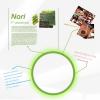Project Members:
daniela
n8agrin
Wesley Willett
infoOD
Unlike many other handmade creations, prepared food is ephemeral; its moment of consumption is unique to the place and time in which it was consumed. But what if aspects of food could last beyond the time of consumption? What if by eating you could access and store information about ingredients, their preparation, and their relationship to the people around them? To cook and eat are activities fundamental to human life. While cooking can involve craft and creative ingenuity, eating can involve reflection, analysis and social interaction. With Information Seasoning, we have explored the possibility of adding (seasoning) and reading (tasting) multi-modal information into the meals we eat. These meals might contain information about the origin of its ingredients, the culinary preparation methods of the meal or memories that can coincide with the experience of eating. Our unique tangible interface explores the resulting ecosystem of interactions one might employ to access the information contained in their meal. We see this action as being both potentially actively and passive, where the act of interpreting the information stored in a meal might be part of the social experience of eating at a restaurant, at home during a family diner, or during the preparation of a meal for a friend.
To highlight the utility of our interface, we have crafted a persona we've named Jane. Jane is a twenty-seven year old who lives and works in San Francisco. She likes to socialize with her friends on the weekends, but most nights she cooks at home with her boyfriend. Both of them enjoy cooking, but are not chefs, per se.
Eating out:
Jane and her friends decide to go to a new sushi restaurant that just opened in North Beach. It's Jane's birthday and without thinking much about it, she brings along her special chopsticks which serve as a tangible interface to the information added into the food at the restaurant. As she and her friends eat, Jane uses subtle gestures to explore her food, querying ingredients (she's a bit allergic to shrimp and wants to avoid them), and seamlessly annotates which sushi pieces she particularly liked. Little did she know that her friends have collaborated with the restaurant owners to make her sushi a bit more special. Because it's Jane's birthday her friends have compiled photos and videos of past social events they have all been a part of. These images are associated with a specific piece of food (her favorite Tuna roll) to recall memories of the first birthday she celebrated with these same friends after just moving to San Francisco. Surprise! She gestures at a Tuna roll and the images tastefully appear on the table, which is itself an interactive screen. These images incite discussion and recall memories of the past five years they have all shared together.
Preparing food:
Jane is cooking some cookies for a friend who is studying abroad. They're her friend's favorite, chocolate cookie with chocolate espresso beans, and she wants to make sure they remind her of home. During the preparation Jane uses specialized cooking utensils which can interact with a visual preparation interface board on her countertop. To make the cookies special, Jane wants to attach photos of her friend's favorite coffee bar to the espresso beans. She does this by tapping once on the photos icon on the preparation board. This action opens a list of photos on the preparation board from which Jane chooses. The images are attached to the beans by gesturing the special mixing spoon over the beans. Once the images have been successfully attached to the beans, the spoon's handle glows blue to confirm the beans have become seasoned with the memory. Had the transfer of the photos not been successful the spoon's handle would have glowed red. Jane finishes up her cookie recipe by adding some more images of the Golden Gate bridge and of downtown San Francisco in a similar fashion.
Eating at home:
Jane and her boyfriend are celebrating their four year anniversary tonight and decided to eat at home. It's a Tuesday and they are planning on going out on Friday to celebrate, but because they each have to work pretty early tomorrow morning they've decided to stay in. Jane loves to collect these memories and archive them in digital scrapbooks. Tonight she is especially taken by the food that her boyfriend cooked (lasagna) and the music that's playing during dinner. Using her special fork she uses a gesture to signify that the current music being played and the food being eaten should be compiled together as a memory and added as a specific entry in her journal. She adds an extra gesture to signify that this particular meal combination is important and wants to add extra metadata to her entry later on (like the fact that was the diner she ate on her anniversary), this way the entry appears with special emphasis on her entries list. Upon recording these gestures the utensil emits a soft blue glow, signifying the gesture was recognized. In this way her interface allows Jane to continue interacting with her food but in a subtle and unobtrusive way which does not interrupt the pleasant conversation and evening that she and her boyfriend are enjoying.

MidTerm poster

infood tabletop mockup



Comments
Feedback
From Ryan:
From Kimiko: